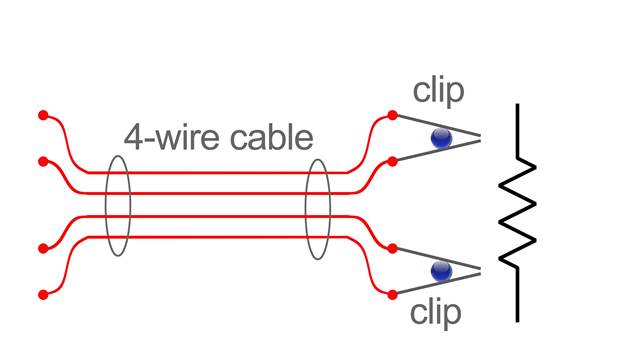Ultra-small resistances and the methods of measuring them accurately
Measuring resistance is usually quite straightforward. You take the Device Under Test (DUT) connect both wires from the Digital Multimetre (DMM) to it and read the result on the screen.
Guest blog by Phil Ebbert, VP of Engineering, Riedon.
However, problems start to arise with this method as the resistance decreases. With extremely small resistances, effects that are negligible when testing larger resistances start to become more important and can no longer be ignored. This means that when testing, these effects have to be either compensated for, or minimised.
Even the DMM leads introduce some extra resistance. If the leads have a resistance of 10mΩ and the DUT measures 1Ω, the ratio between the two means the error is only around 1% of the measurement. But if the DUT is under 100mΩ, then the margin of error rises to around 10% of the measurement. A technique that has been successfully used for measuring resistances at this scale is the four-wire Kelvin method. Shown below, the Kelvin method uses one pair of leads to measure current and the other to measure voltage.
The current source for the measurement is highly accurate and has very low impedance to auto-compensate for the resistance of the leads. The voltage circuit uses a voltmeter with very high input impedance, usually in the 1 MΩ region. The resistance of the leads is now very small when added to the source impedance and therefore loses its significance in the final measurement. All instruments designed for precision measurements support the Kelvin method.

The Kelvin technique is very useful until the resistance of the DUT drops under 100mΩ. At this level of resistance, the current required for an accurate test is higher than the typical DMM can provide, which is usually about 10mA. If the DUT is 10mΩ, the current available will only give a 0.1mV signal, which will be difficult for even a 7.5 or 8.5 digit DMM to measure. Therefore, resistances at this level usually require a specialised micro-Ohmmeter that is able to source a current of 1A or more.
When the DUT resistance drops below 1mΩ, measurement requires a different and more complex high current shunt set-up, as shown in figure two. This set-up calculates the measurement using the ratio between the DUT and a known precision resistance, which has been hooked up in series. The series set-up means that the current through both resistors is identical, and the DUT resistance can then be calculated using the formula:

Using this type of measurement requires a high, stable current source to produce an appropriate voltage signal. Above 5mV is usually required, which is available from most capable DMMs. The precision resistor is required to be within an order of magnitude of the resistance being tested. For instance, a known, precision resistance of 1mΩ can be used to measure a DUT in the range of 0.1mΩ to 10mΩ.
A second effect that cannot be ignored when measuring low resistance is temperature. The reason thermal effects become important is because of the thermocouple effect, which generates a small voltage where the leads touch the DUT. This effect can be minimised if the test instrument has built-in compensation, or if the connections are manufactured from copper. Two schemes have been used to compensate for thermal effects.
The first of those, offset compensation, measures the thermal voltage at zero current, and then subtracts it from the final reading. The second method, current reversal, takes measurements at both current polarities and gives an average reading of the two results. Both these methods require two measurements to be taken very quickly, one after another, to compensate for fluctuating temperatures.
If the temperature is not stable, a third technique can be used. The Delta method is an extension of the current reversal method, which repeats the double polarity measurement several times quickly to measure any voltage drift.
The current applied to take a measurement can also have an effect on the final reading. A high current is viewed as favourable to get more accurate readings, but if the current is too high it will cause large power dissipation in the DUT, changing its resistance, while increasing the thermocouple effect. To get around this situation, instruments can pulse the current, or use a low power mode.
It’s not just the current that can affect the reading. Very low voltages also may not be exactly proportional to the current because of an oxide film on the metal contact. A simple way to get around this problem is to change the DMM’s range to check for consistency. Indium or gold contacts can be combined with an increased voltage and offset compensation to deal with non-ohmic contact resistance.
Fortunately, most precision test equipment is built to take the factors that affect accuracy into account during measurements. Today’s equipment can automatically apply compensation to allow for any inaccuracies and ensure a true resistance reading. However, it is still helpful to learn how different effects can be introduced into the measurement process and the best methods of counteracting them.
Download the resistors e-book for more information on resistance and measurement.
Courtesy of Riedon.










